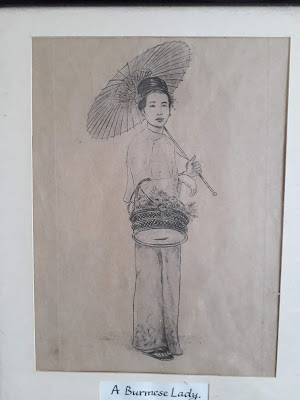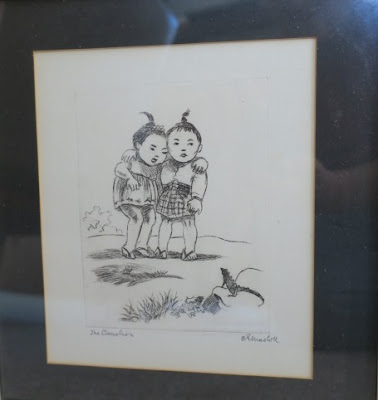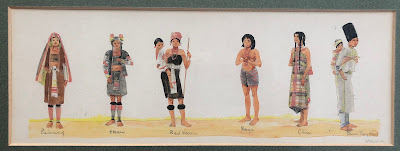There is, however, at least one artist whose entire print output appears to have been devoted exclusively to Burma (known today as Myanmar), an Anglo-Burmese artist named E.G. MacColl (1896-1973). Information about MacColl has been exceeding hard to locate. For the longest time, I assumed that he was a British soldier who was stationed in Burma during WWII. Efforts to find soldiers who may have served with MacColl in Burma and who remembered him were unsuccessful. However, I was eventually able to make contact through an on-line RAF bulletin board with MacColl's grandneice, Alison Denmark, who was coincidentally researching her own family tree.
I was able to learn from Alison that MacColl's full name was Eric Gordon MacColl. He was born in Maymyo, Burma, the son of Hugh Ernest MacColl, a Judge of the High Court of Judicature at Rangoon and the Burmese Princess Ma Phyu. His grandfather was the Scottish mathematician, logician, and novelist Hugh MacColl. E.G. MacColl had 11 brothers and sisters, including Alexander Malcolm MacColl, a member of the Burma Imperial Police and an Assistant to the Deputy Inspector General of Railways at Rangoon. and Hugh Herbert MacColl, a district forestry officer in Burma. During WWI, he was an acting corporal in the British Fusiliers (City of London Regiment), where he won the British War Medal and Victory Medal.
MacColl was an artist well known throughout Burma particularly for his etchings of local scenes and his portraits of men and women of the various Burmese peoples in
their traditional costumes, although it is unclear if he ever had any formal art training. His paintings in particular show an anthropological interest in the
various Burmese ethnic groups, He also decorated scarves, lamp shades, wall plaques
and other bric-a-brac.
It is unclear if he served in any official capacity during WWII, although he clearly had some relationship with members of Britain's Royal Air Force No. 181 Signals Wing
Corps that was stationed in Burma. It is well documented that No. 181 Signals Wing
Corps was formed on June 9, 1943 and disbanded on March 10, 1946. This
unit began in Imphal, India, proceeded down through Burma to Rangoon,
then on to Malaya and Singapore, and finally to Java and Sumatra. MacColl seemed to have been able to sit out most of the war under the Japanese radar because he lived as a Burmese native and had a Burmese wife. At some point during the war, however, MacColl was interned by the Japanese (as was his brother Alexander). According to one report, while under arrest on suspicion of spying, MacColl kicked a Japanese officer who shot
at him twice with his revolver, but fortunately the gun misfired.
MacColl's etchings found a receptive audience with British servicemen looking for local souvenirs of their time in Burma. One serviceman who was friends with MacColl said that he would sell his etchings for alcohol. His figurative etchings realistically depict the Burmese people in a sympathetic manner, albeit perhaps through a colonial gaze that tends to depict them with an exaggerated sense of contentment with their lot. His landscape etchings, on the other hand, are filled with vivid shorthand renditions of village life, temples, huts, moats, and paddy boats.
MacColl's etchings are notoriously hard to find in good condition. This is no doubt largely due to the fact that high quality paper was not available to MacColl during the war, and the extremely humid weather conditions of Burma made them particularly susceptible to foxing. In fact, paper itself was of such short supply that it is not uncommon to find MacColl's etchings printed on the back of military maps. They are also found frequently folded or creased, no doubt because the Corps was constantly packing up and moving from place to place and/or because they were folded when mailed home to family and loved ones.
MacColl's post-WWII years are almost as mysterious as his life before the war. His nickname was "R.C.P." (for Roman Catholic Priest) by family members, though no one knows why. It does suggest, however, that he led a rather ascetic lifestyle and may have been religious. Frank Silverstein, who as a child met McColl at his home in Maymyo in 1961, said his place was "huge and piled high with curios and junk and scarps of things collected over his lifetime. It was much more like a barn than a hut!' To Silverstein, MacColl "seemed like a hermit and a tinkerer." He also said that MacColl's etchings were made with the use of discarded dental X-ray plates.
In 1963, MacColl provided illustrations for the Burma Baptist Chronicle, a history of the Burma Baptist Church. Given that many of the illustrations depict events that took place before MacColl was born, they would appear to have been commissioned specifically for this publication, rather than taken from his war-time sketchbooks. None correspond to any known MacColl etchings. He died a decade later in poor circumstances, in a dilapidated hut in Maymyo littered with his artwork. His friends saw to it that he was given a dignified funeral. Today, the Denison Museum in Granville, Ohio has a sizable, though as yet uncatalogued, collection of MacColl's work. His work can also be found at the Brighton Museum.
There is, as yet, no catalogue raisonné for MacColl’s prints, so the following list is undoubtedly incomplete. If a reader is aware of a missing design, please let me know and I will add it to the list. MacColl’s etchings are usually, though not always, titled in the plate or else titled by hand in pencil. Where an actual title is unknown or indecipherable, the descriptive title assigned to it by a cataloger or dealer has been provided in brackets. All of his etchings appear to be undated, but they all presumed to date to the 1940s.
Courtesy of Alison Denman
Courtesy of a British Collector
Courtesy of Albion Prints
Courtesy of Richard Jenner
Courtesy of Josef Lebovic Gallery
Courtesy of Maggie Bruno
Courtesy of Albion Prints
Note: This is a very slightly cut-down version of A Flooded Village, Sitang River
Courtesy of Alison Denman
Courtesy of Ian Stewart
Courtesy of Alison Denmark
A Jungle Village (II)
Courtesy of Judith Oliver
(pencil drawing)
Karen Frog Drum (paper:11-1/4 x 10 in.)
Karens Fetching Water (plate: 26 x 15.3 cm)
Courtesy of a British Collector
Kipling's Moulmein Pagoda (paper: 21 x 26 cm)
Note: This appears to be a cut-down and reworked version of Log Depot on the Sitang River.
Courtesy of Catriona Hamilton
Note: This appears to be a cut-down version of Kipling's Moulmein Pagoda.
Courtesy of Richard Jenner
Note: This appears to be a later proof with more detail but with a narrower plate.
The Palace - Mandalay
Courtesy of Judith Oliver
(pencil drawing)
The Palace Mandalay
Courtesy of Alison Denmark
A Phongyi (paper: 25 x 20 cm)
Courtesy of a British Collector
Courtesy of a British Collector
Note: Compare this design with "A Laing."
aka The Duke Of York's Nose - The Salween River
Note: This appears to be a cut-down and reworked version of "Sagaing."
Courtesy of Albion Prints
Courtesy of Catriona Hamilton
A Shan Interior
Courtesy of Ian Stewart
Shan Maymyo
Courtesy of Richard Jenner
The South Moat Mandalay (plate: 24.6 x 31.8 cm)
Courtesy of a British Collector
The Water Pot
Courtesy of Alison Denmark
Courtesy of Albion Prints
Other Known Titles (possibly alternate titles for certain of the above prints):
At the River
Bamboo Water Bottles (17.7 x 13.9 cm)
Burmese Dancers
Corner of South Moat
Dancers (15.8 x 18.4 cm)
Man with a Basket (19.6 x 13.3 cm)
Native Boat (13.9 x 19.6 cm)
A Shan Woman
The White Cheroot
March 31, 2018 Addendum -- A reader wrote in to tell me about some watercolors he had inherited from his late father, who had been a British diplomat in Burma. I recognized them as being very similar to a set of putative watercolors I had seen for sale at a on-line gallery. I began to wonder if they might actually be hand-colored etchings rather than pure watercolors, and was able to get the owner to confirm that they had plate impressions.
In the following case, however, the figures are slightly out of order. I think might be the original watercolor for the etching. I'm also beginning to wonder if the mixed media portraits at the beginning of this post might actually be hand-colored etchings as well.
by E.G. MacColl
* * *
If a comment box does not appear below, click on this link instead: http://easternimp.blogspot.com/2016/04/on-road-to-mandalay-burmese-etchings-of.html



















































































 <
<










































My family has 10 of his pencil drawings, bought by my late father when serving in the Chin Hills Bn in the war. They are on the reverse of British army maps which are over printed in Japanese. The maps had been taken from the bodies of British soldiers, sent to Japan and issued to Japanese troops. McColl obtained the map paper from dead Japanese soldiers.
ReplyDeleteI knew he printed on old maps, but not where they maps came from, though I assumed from the British Army. You may wish to example your pencil drawings closely to make absolutely sure they are not prints. McConnell often printed them rather faintly, so they can appear to be drawings when they are not. The thing to look for is a plate impression around the design.
ReplyDeleteThey definitely aren't as my father bought them unframed from MacColl himself. He (my father) was Capt ACB Hunt, Chin Hills Bn, Burma Regt, Indian Army. On the orders of FM Slim, he established the School of Jungle Warfare in Maymyo. We have the letter from his CO commending him on successfully doing this. The story behind the maps is that when the Japanese came into the war they had few accurate maps of Burma and so were instructed to take British army issue maps whenever they could.
DeleteInteresting. Do any of your pencil drawings correspond to print designs?
DeleteSeveral. EG: Women at the well. A Burman. A Burmese lady. Shwe Dagon. I think my sister in Australia has one of the Salween. It's interesting that the map you show above doesn't have the red Japanese overprinting which ours do. These were taken from the dead Japanese soldiers. My email address is juditholiver277@gmail.com if you need to communicate directly. Regards.
DeleteI am in possession of 6 pencil signed black and white prints and a hand colored print with full pencil signature dated 1926-July 31st. My late wife nee Winifred Jean Ellis and her sisters were born in Moulmein and these have been in the family since my inlaws lived there in 1925.I would be happy to photograph what I have and forward them to you.
ReplyDeleteIf any of the prints are of images not found in this article, I would be happy to add them to it. I can be contacted at the e-mail address at the upper right of every page.
DeleteI have 17 of MacColl's prints,(I think all are prints) all of which are shown in the pictures above. Some are on the back of old maps. The picture which you show as Bazaar, is called The Market on my copy. Also I have 2 coloured unsigned crescent shaped pictures of ethnic people and scenes which I am sure are lampshades which are not shown here.
ReplyDeleteMacColl does not always seem to be consistent in his titling of prints (or else he reworked them in ways that are not entirely obvious). I have noted the alternate title for The Bazaar. If you have images of the lampshades you wish to share, you can e-mail them to the address at the top right of this page and I will consider adding them to the article.
DeleteThanks, I have emailed you.
ReplyDeleteHello,
ReplyDeleteToday I came across three MacColl, what appear to be pencil drawings: Entrance to Village, Bamboo Huts and one I didn’t see above: Bougainvillia (sp) Tree. They were all framed, it appears, at L. A. Bigelow Inc. Art Dealers 42 Bromfield Street, Boston
I’ll try emailing you the images.
Use the email address at the upper right of the blog.
DeleteDo you know of any examples of MacColl's wall plaques please? I have some wall plaques and would like to know if they might be by him.
ReplyDeleteI've never seen any of MacColl's wall plaques, sorry.
DeleteI have 7 of his prints; assumed that all were originals based on what my dad told me. He said that they were drawn by an army buddy of his (my dad served in Burma during WW2). That said, my father loved to tell tall tales, so who knows what was true or not. All but 1 are signed. All are drawn on the back of maps. I had one mounted with glass on the back so you can see the actual map. I'd love to share the images with you!
ReplyDeleteIf you have images of prints I don't already show on this blog (or better images than the ones I already have), you can sent them to me at the address in the upper right of the blog.
DeleteI have 4 what seem like pencil drawings (although maybe etchings) by the artist brought home from Burma by my father who served there in WWII
ReplyDeleteAll are framed - I’m reluctant to take them out of frames to check out the reverse.
MacColl's etchings are frequently mistaken for pencil drawings. One should look for a (usually) faint plate mark impression.
DeleteI have last three etchings of the bottom series (with white background) of your article. Two of them are signed with a pencil. The outlines of the characters are very thin and delicate, and the colors are, of course, completely different. I'm just wondering where my late father-in-law got them from. He was a soldier in the war himself, but in the Finnish army. He also a painted himself, and was a diligent and optimistic collector,
ReplyDeleteMy father bought a whole collection of etchings while serving in Royal Signals in the second world war in Burma. My sister and I have the collection between us. Mine are: A Burmese Pottery, The 'Pive'(?), A Burmese Lady, Burmese Girl.
ReplyDeleteHave 7 signed in flat,non creased condition
ReplyDelete